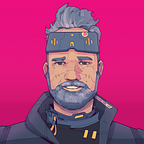3 Ways of Seeing Brand Patterns
If you design for the web or mobile you might be familiar with UX Patterns. These are solutions that work and are adopted by others.
Another word we can use to describe “solutions that work” is the sports term “Playbook.” Once you find a few “plays” that work you can repeat them over and over again.
We see brand patterns everyday. In the fast food franchise, the gas station, the clothing retailer, the yoga studio, the artisanal cheese shop, the baker and the candle stick maker.
You are also in a brand pattern. For both your work and your personal life. You are a designer and a “great dad”, an entrepreneur and “an amazing mom”, a friend and “a great lover.” There are many categories and attributes that define you inside your community. You might even have multiple work brand patterns running at the same time.
I divide “Brand Patterns” into 3 parts:
- The Business Model
- Delivery Patterns
- Wisdom & Intuition
1. The Business Model
“A business model describes the rationale of how an organization creates, delivers, and captures value.” — Business Model Generation by Alexander Osterwalder & Yves Pigneur
During one of my past webinars, Chris Boston (an awesome member of our community,) noted that in order to understand how best to design for a business, it was important for designers to first understand the Business Model Canvas. I totally agreed with him and have incorporated this into this upcoming webinar. The best way I can describe the Business Model Canvas is as a one shot view of the dynamics of an entire business; who your customers are, what the value you provide to them, what problems you solve for them, how you deliver, what it costs -and of course- how you make money all in one view.
Here are some common business models you might have heard about:
- The Franchise Store (Eg. McDonald’s is an example of a franchise.)
- The SAaS Software Provider. (Eg. If you use Squarespace or Wix to build a website, those are Software as a Service products.)
- The Boutique Yoga Studio. (Eg. Your corner studio owned by one person.)
- The Local Church. (Eg. Your local Catholic Parish is part of a global organization HQ’d in Italy run by a super sweet guy from Argentina.)
All of these models have brands (the way they are perceived by their customers) and brand identities (logos, typography, printed materials, websites, signage.) All of these models have communities that use and love them. Their brand identities play an important role in their models — BUT one of the most important things to know - is that their identity is not their brand. Their brand is the sum of all of their parts as perceived by YOU. As you walk outside today, take a look around. What business models do you see? How do they make you feel based on what you see and how you interact with them? That feeling you get, is their brand.
2. Delivery Patterns
If you watch or play American football, basketball or soccer, you might be familiar with how coaches diagram the different “plays” they run to get the ball to the goal.
They have crazy names like the “Flea Flicker” and historical names like“Blitzkrieg.” But they all have one thing in common, they map out how to deliver the ball to the goal. Within each game, there are different dynamics but they all have the same things in common; a field and players running a ball to a goal. Businesses are similar. They all have a field (online or offline) with customers to which they are delivering value. McDonald’s delivers breakfast at a low cost, Wix lets you build your website yourself, the Yoga Studio lets you reduce stress, feel good and get fit, and your local congregation gives you a spiritual community and peace of mind. Inside all of these businesses there are people, industry standard play books and brand touch points.
3. Wisdom & Intuition
If the Business Model is the “big picture” and Delivery Patterns are “the model in action” then Wisdom and Intuition are for the designer or entrepreneur, the results of doing these over and over again. As a wise startup advisor told me, “I have seen this movie before.”
It is hard to gain either Wisdom or Intuition without playing the game. In today’s game the best thing a designer (or anyone who wants to build or help build a great brand) can do is to build their own businesses.
For example, the brand we know as Jose Caballer has been practicing these principles since he was a tadpole. At 7 he sold candy to classmates during recess at 100% profit margins because his grandma was his (free) supplier. At 10, he sold handmade packing foam and chipboard replicas of the Imperial Shuttle for $7 to his classmates who asked where he got it. “I made it from shoe boxes, packing foam, glue and tempera”— was the response. At 29, he transitioned from a freelance designer in his loft to having an agency by making a business plan and showing it to his old boss at the digital agency he used to work at. At 39, he used the same business plan as his first product when he started a school to teach other designers how to run their own businesses.
When he is not causing trouble at co-working spaces or consulting startups, Jose can be found teaching his CORE Masterclass series online.
Join the product and design professionals reading Noteworthy to understand the ideas and people that shape the products we use every day (and get an early peak at our product!).
If you have thoughts to share, we accept post submissions!
